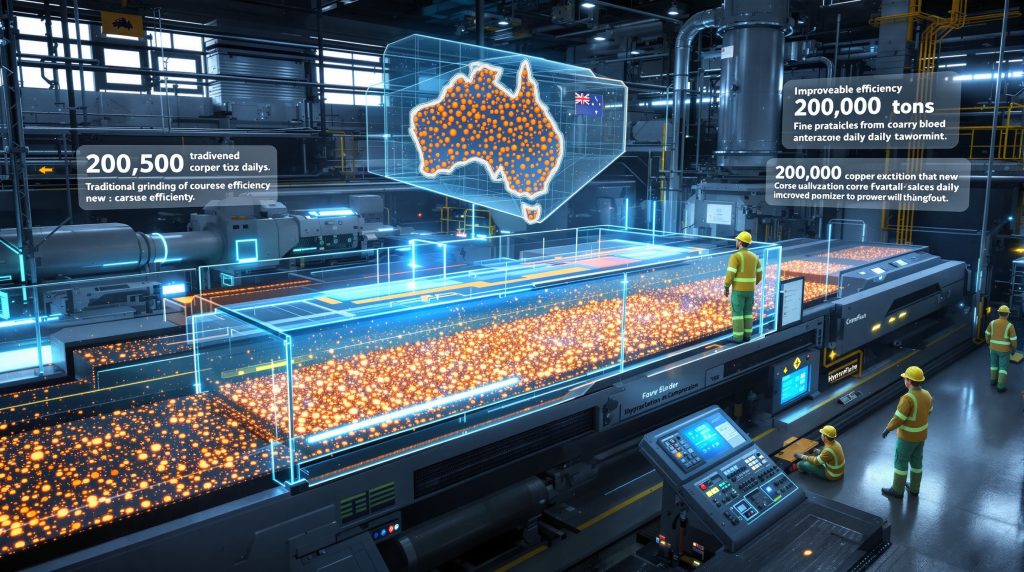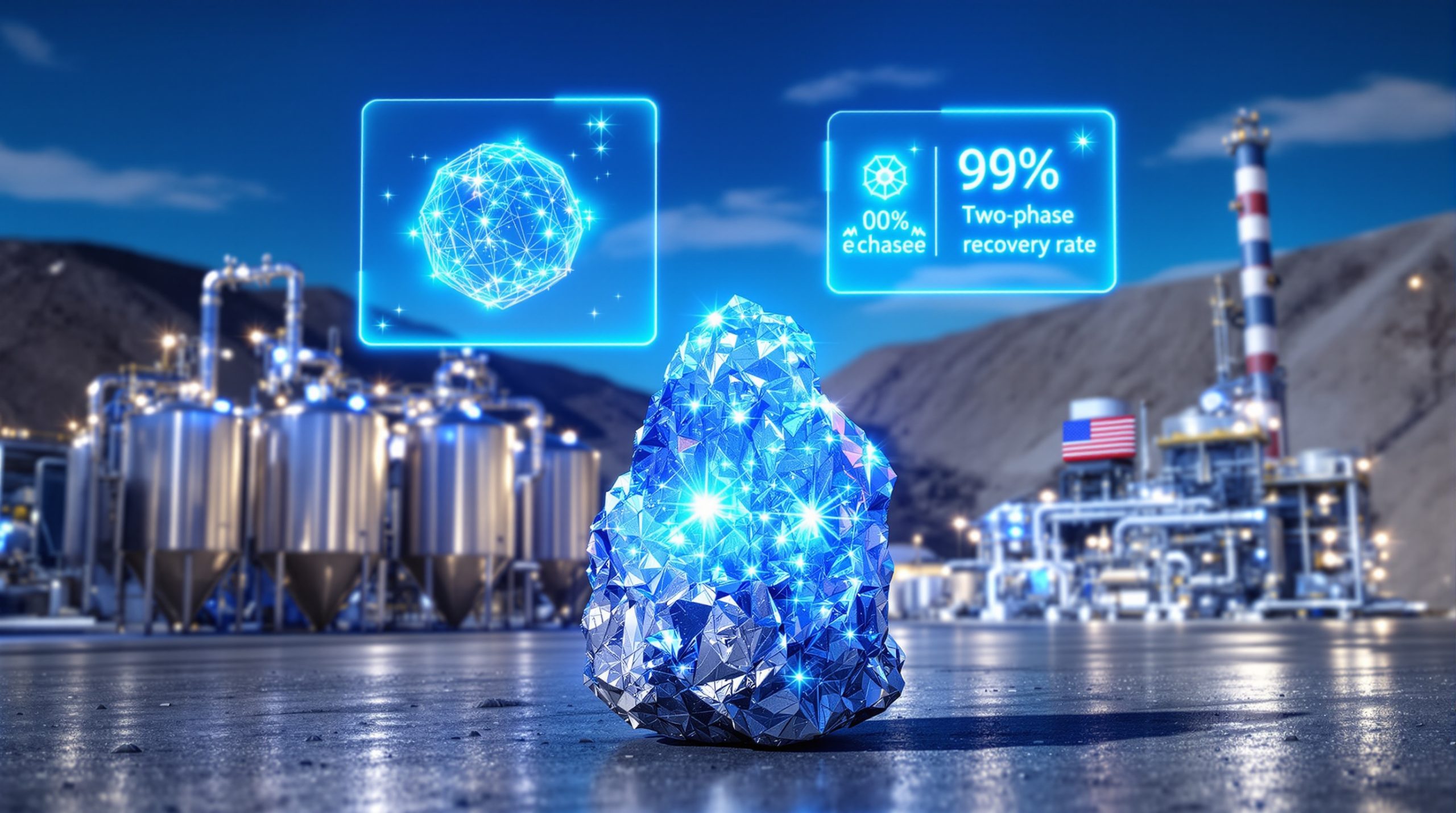What is HydroFloat Technology and How Does it Work?
HydroFloat technology represents a significant advancement in mineral processing designed to recover coarse particles that would otherwise be lost in conventional flotation. This innovative approach creates a fluidized bed environment where larger mineral particles can be effectively separated and recovered, dramatically improving efficiency compared to traditional methods.
Understanding Coarse Particle Flotation Technology
Coarse particle flotation (CPF) technology fundamentally changes how mining operations process ore by enabling the recovery of valuable minerals at significantly larger particle sizes. The HydroFloat system specializes in capturing these coarse, high-value particles that conventional flotation processes typically lose to tailings.
Unlike traditional flotation cells that struggle with larger particles, HydroFloat creates optimal conditions for coarse particle recovery, allowing mining industry innovation to reduce grinding requirements while maintaining or improving overall mineral recovery.
The Technical Principles Behind HydroFloat
The HydroFloat system operates through a specialized chamber that combines fluidization and flotation principles. Within this controlled environment, air bubbles attach to valuable mineral particles suspended in a teeter-bed arrangement. This unique combination creates ideal conditions for bubble-particle attachment even at coarser grind sizes.
The technology uses differential density and specialized hydrodynamics to maintain particles in suspension, giving them extended residence time for interaction with air bubbles. When air bubbles successfully attach to mineral particles, the combined structures become buoyant enough to rise to the surface for collection, while waste material continues through the system.
This selective separation occurs at significantly coarser grind sizes than conventional flotation cells can achieve, offering substantial operational benefits across multiple dimensions of mineral processing.
Why is BHP Implementing HydroFloat at Carrapateena?
BHP's decision to implement HydroFloat technology at the Carrapateena copper mine addresses several critical operational challenges while advancing the company's sustainability objectives. The strategic implementation delivers benefits across multiple operational fronts.
Strategic Benefits for Copper Production
The primary motivation behind BHP's HydroFloat implementation centers on increasing processing capacity while maintaining recovery rates. The technology enables Carrapateena to boost ore throughput to approximately 20,000 metric tons per day—a substantial increase that enhances the mine's production capabilities.
By recovering valuable minerals that would otherwise report to tailings, the HydroFloat system improves overall metal recovery rates. This efficiency gain effectively extends the productive life of the mineral deposit without expanding the physical footprint of mining activities.
The technology also addresses one of mining's most energy-intensive processes: grinding. By enabling effective mineral beneficiation insights at coarser grind sizes, the system reduces power consumption in crushing and grinding circuits, creating both cost savings and environmental benefits.
Sustainability and Operational Advantages
From a sustainability perspective, the HydroFloat implementation delivers multiple benefits that align with BHP's broader environmental objectives:
- Reduced power consumption through coarser grinding requirements, lowering the operation's energy intensity
- Improved water efficiency in the processing circuit through more effective mineral separation
- Enhanced tailings management with coarser particles that offer improved geotechnical properties
- Lower carbon footprint per ton of copper produced through reduced energy requirements
- More efficient resource utilization that maximizes recovery from existing operations
The technology represents what Anna Wiley, Asset President for BHP Copper South Australia, describes as "a compelling example of the smart technology, innovative thinking and investment in productivity" that will advance BHP's operations in South Australia. As the first implementation of HydroFloat technology within BHP, the Carrapateena project establishes an important precedent for potential wider adoption across the company's global operations.
How Will the HydroFloat Installation Transform Carrapateena's Operations?
The implementation of HydroFloat technology at BHP's Carrapateena mine delivers transformative operational improvements across multiple dimensions of the mining operation, from throughput and recovery to energy efficiency and sustainability.
Capacity and Throughput Enhancements
The most immediately measurable impact of the HydroFloat installation is the increase in ore processing capacity to approximately 20,000 metric tons per day. This substantial throughput improvement allows the operation to process more material while maintaining recovery rates—effectively increasing copper production without proportional increases in energy consumption or environmental footprint.
The technology achieves this by fundamentally changing how the processing circuit handles ore particles. By recovering minerals at coarser grind sizes, the system reduces the burden on grinding circuits, allowing them to process more material while using less energy per ton.
The combination of increased throughput and maintained recovery rates translates to more efficient copper production that maximizes the value obtained from each ton of ore extracted from the underground mine.
Recovery and Efficiency Improvements
Beyond throughput enhancements, the HydroFloat system delivers important operational efficiency improvements:
| Performance Metric | Improvement |
|---|---|
| Overall metal recovery | Significant increase through capturing previously lost coarse particles |
| Energy consumption per ton | Reduced due to coarser grinding requirements |
| Processing capacity | Increased to ~20,000 mt/d |
| Grinding fineness required | Coarser (less energy-intensive) |
| Tailings particle size | Larger (improved geotechnical properties) |
The combined effect of these improvements creates a processing circuit that operates more efficiently across multiple dimensions. The reduction in energy requirements for grinding—typically accounting for 30-50% of a mine's energy consumption—delivers particularly significant operational cost benefits while reducing environmental impact.
By allowing the recovery of valuable minerals at coarser particle sizes, the system also improves the overall resource efficiency of the operation, extracting more value from each ton of ore while reducing waste material.
Who Collaborated on the Carrapateena HydroFloat Project?
The successful implementation of the HydroFloat system at Carrapateena resulted from close collaboration among multiple organizations with complementary expertise and capabilities. This partnership approach enabled the project to meet performance targets on an accelerated schedule and within budget constraints.
Key Partners in Implementation
Four main organizations played central roles in bringing the HydroFloat technology to operational status at Carrapateena:
-
BHP: As project owner and operator of the Carrapateena mine, BHP provided operational expertise, site knowledge, and project management capabilities that ensured successful integration with existing systems.
-
Eriez: The technology provider and developer of the HydroFloat system brought specialized knowledge of coarse particle flotation technology and experience from previous implementations in other operations.
-
VOLPRO Pty Ltd: This engineering and installation partner managed key aspects of the physical implementation, ensuring proper integration with existing circuits.
-
Paradocs Metallurgy: Specialized metallurgical optimization expertise helped fine-tune the system for Carrapateena's specific ore characteristics and operational requirements.
Jose Concha, Global Director of Mining Products at Eriez, noted that "BHP's focus on innovation and operational excellence was critical to the success of this project," highlighting the importance of the collaborative approach.
Project Execution and Timeline Achievement
The implementation team successfully completed the project on an accelerated schedule while maintaining performance targets and budget constraints. This achievement underscores both the effective collaboration between technical teams and the maturity of the HydroFloat technology for commercial deployment.
The successful commissioning involved several phases:
- Initial engineering and design integration with existing circuits
- Physical installation within the operating plant
- Commissioning and startup procedures
- Optimization to achieve target performance metrics
The partnership approach created a foundation for ongoing collaboration, with the partners planning to "continue to refine the technology and CPF flowsheets, share insights, and evaluate opportunities to expand HydroFloat applications across other operations."
What Makes This Installation Significant for the Mining Industry?
The implementation of HydroFloat technology at Carrapateena represents more than just an operational improvement at a single mine—it establishes an important precedent for the broader adoption of coarse particle flotation technology across the mining industry.
First-of-its-Kind Implementation for BHP
As Anna Wiley, Asset President for BHP Copper South Australia, emphasized, this HydroFloat installation represents "a first-of-its-kind for BHP." The successful implementation at Carrapateena establishes a potential template for future deployments across BHP's global operations.
For a major mining company like BHP to adopt this technology at a significant operation like Carrapateena sends a strong signal about the commercial viability and operational benefits of coarse particle flotation. The implementation demonstrates BHP's commitment to innovative technologies that can simultaneously improve productivity and sustainability.
The project also represents what Wiley describes as "a compelling example of the smart technology, innovative thinking and investment in productivity that will carry our business forward in South Australia," highlighting its strategic importance to BHP's regional operations.
Industry-Wide Implications
Beyond BHP's operations, this successful deployment has significant implications for the broader mining industry. The implementation is described as "paving the way for broader adoption of HydroFloat CPF in base and precious metals processing," indicating its potential to transform mineral processing approaches industry-wide.
The Carrapateena installation provides valuable operational data and performance metrics that can inform similar implementations at other mines globally. As the industry increasingly focuses on improving energy efficiency, water management, and tailings characteristics, the demonstrated success of coarse particle flotation technology offers an important pathway for addressing these challenges.
The partners' commitment to "continue to refine the technology and CPF flowsheets, share insights, and evaluate opportunities to expand HydroFloat applications" further underscores the installation's role as a stepping stone toward broader industry adoption.
How Does HydroFloat Technology Support Sustainable Mining Practices?
In an era where mining operations face increasing pressure to improve environmental performance, HydroFloat technology offers multiple pathways to enhance sustainability while maintaining or improving economic outcomes.
Environmental Impact Reduction
The technology contributes to more sustainable mining operations through several mechanisms:
-
Decreased energy intensity: By enabling mineral recovery at coarser grind sizes, the technology significantly reduces energy requirements for grinding—typically one of the most energy-intensive processes in mineral processing.
-
Reduced grinding requirements: Beyond energy savings, reduced grinding means less wear on equipment, fewer replacement parts, and lower consumption of grinding media like steel balls.
-
More efficient water use: The flotation process in the HydroFloat system optimizes water consumption through more effective particle-bubble interaction and separation.
-
Improved tailings characteristics: The coarser particle size distribution in tailings can improve geotechnical stability and potentially reduce long-term environmental risks associated with tailings storage.
These environmental benefits align with the mining industry's increasing focus on reducing carbon footprint, water consumption, and overall environmental impact while maintaining production capacity.
Resource Efficiency Improvements
Beyond direct environmental benefits, HydroFloat technology enhances the resource efficiency of mining operations:
-
Increased mineral recovery: By capturing valuable minerals that would otherwise be lost to tailings, the technology improves the overall resource efficiency of the operation.
-
Extended mine life: More efficient processing effectively extends the productive life of mineral deposits without expanding the physical footprint of mining activities.
-
Reduced waste production: Improved recovery rates mean less valuable material reporting to waste streams, improving the ratio of product to waste.
-
Lower intensity per unit of production: The combination of higher recovery and reduced input requirements (energy, water, grinding media) lowers the environmental footprint per unit of copper produced.
These efficiency improvements represent an important pathway toward more sustainable mining practices that maintain economic viability while reducing environmental impact—a critical balance as the industry faces increasing pressure to improve performance on both dimensions.
What Results Has the Carrapateena HydroFloat Plant Achieved?
The HydroFloat plant at Carrapateena has transitioned from project implementation to operational reality, delivering performance results that validate the technology's potential for copper processing applications.
Initial Performance Metrics
According to available information, the HydroFloat plant is "fully operational and producing results in line with expectations." This indicates the technology is successfully achieving the targeted improvements in throughput and recovery while delivering the anticipated operational efficiency gains.
The plant has successfully integrated with the existing processing circuit at Carrapateena, demonstrating the adaptability of HydroFloat technology to established operations. This successful integration represents an important milestone, as retrofitting new technology into existing circuits often presents significant technical challenges.
The system is processing ore at the targeted throughput rate of approximately 20,000 metric tons per day, marking a substantial capacity increase for the operation. This throughput improvement comes while maintaining recovery rates—a critical factor in the project's overall success.
Ongoing Optimization Efforts
While the initial performance metrics demonstrate success, BHP, Eriez, and their partners continue to refine the technology and optimization efforts:
-
Flowsheet refinement: The partners are actively working to further optimize the CPF (coarse particle flotation) flowsheets based on operational experience and performance data.
-
Knowledge sharing: The collaborative approach extends to sharing insights gained from the implementation, creating a foundation for future deployments.
-
Expansion evaluation: The partners are evaluating opportunities to expand HydroFloat applications across other operations, indicating confidence in the technology's potential.
This ongoing optimization and knowledge-sharing approach will generate valuable insights that can be applied to future HydroFloat installations, both within BHP's portfolio and potentially at other mining operations globally. The continuous improvement process represents an important aspect of the technology's overall implementation strategy.
How Does This Technology Fit Within BHP's South Australian Operations?
The HydroFloat implementation at Carrapateena represents a strategic enhancement to BHP's broader copper operations in South Australia, strengthening the company's regional processing network and supporting long-term productivity objectives.
Integration with Regional Processing Strategy
BHP's Copper South Australia operations encompass three underground mines—Olympic Dam, Prominent Hill, and Carrapateena—which feed a centralized smelter and refinery at Olympic Dam. This integrated network forms a core component of BHP's copper production capabilities in Australia.
The HydroFloat technology at Carrapateena enhances the efficiency of this regional processing network by improving recovery rates and increasing throughput capacity. These improvements contribute to the overall productivity of BHP's South Australian copper operations without requiring proportional increases in energy consumption or environmental footprint.
By implementing the technology at Carrapateena, BHP creates opportunities to evaluate its potential benefits for other operations within the regional network. This staged approach to technology adoption allows for operational learning and optimization before potential broader deployment.
Strategic Alignment with Growth Objectives
The implementation aligns closely with BHP's strategic objectives for its South Australian copper operations, supporting increased production while improving sustainability metrics:
-
Productivity enhancement: The technology delivers on BHP's goal of improving productivity through innovation rather than solely through resource expansion.
-
Sustainability improvement: Reduced energy requirements and improved tailings characteristics align with BHP's environmental performance objectives.
-
Operational efficiency: The technology enhances the operational efficiency of existing assets, maximizing value from current infrastructure.
-
Technology leadership: As a first-of-its-kind implementation for BHP, the project positions the company at the forefront of adopting innovative processing technologies.
Anna Wiley's characterization of the HydroFloat as "a compelling example of the smart technology, innovative thinking and investment in productivity that will carry our business forward in South Australia" underscores its strategic importance to BHP's regional operations and future development plans.
What Future Applications Might HydroFloat Technology Have?
The successful implementation of HydroFloat technology at Carrapateena opens pathways for broader applications across the mining industry, with potential for deployment in various mineral processing contexts and geographical locations.
Potential for Broader Implementation
The successful commissioning at Carrapateena establishes a foundation for wider adoption of HydroFloat technology across the mining industry:
-
Additional BHP operations: The company may evaluate implementing the technology at other copper operations within its global portfolio, leveraging learning from the Carrapateena installation.
-
Other base metals: While implemented for copper at Carrapateena, the technology holds potential for application to other base metal operations, including lead, zinc, and potentially nickel processing.
-
Precious metals recovery: The principles of coarse particle flotation may also apply to precious metals recovery, potentially expanding the technology's application to gold and platinum group metals processing.
-
Polymetallic ores: Operations processing complex, multi-element ores could potentially benefit from the technology's ability to recover various minerals at coarser grind sizes.
The partners plan to "evaluate opportunities to expand HydroFloat applications across other operations," indicating active exploration of these broader implementation possibilities.
Technology Evolution and Refinement
As operational experience with the HydroFloat system grows, several evolutionary pathways for the technology emerge:
-
Process optimization: Continued refinement of operating parameters and flotation chemistry to maximize performance for specific ore types.
-
Integration with digital technologies: Potential combination with advanced process control, machine learning, and predictive analytics to further optimize performance.
-
Scalability improvements: Engineering enhancements to facilitate implementation at different scales, from smaller operations to very large processing plants.
-
Complementary technology integration: Exploration of how HydroFloat can work alongside other emerging modern mining technology like pre-concentration and sensor-based sorting to create comprehensive efficiency improvements.
These evolutionary pathways suggest that the Carrapateena implementation represents an important step in a longer technology development journey rather than a final destination. The collaborative approach among BHP, Eriez, and their partners creates an environment where this ongoing refinement can occur effectively, potentially accelerating the technology's broader adoption across the mining industry.
FAQ: HydroFloat Technology at Carrapateena
What specific minerals does the HydroFloat technology recover at Carrapateena?
The HydroFloat technology at Carrapateena primarily targets copper sulfide minerals, which are the main valuable components in the ore. The system is particularly effective at recovering coarse copper-bearing particles like chalcopyrite that would be lost to tailings in conventional flotation systems. The technology can potentially recover other valuable minerals present in the ore, though copper represents the primary target at this operation.
How does coarse particle flotation differ from traditional flotation methods?
Coarse particle flotation fundamentally changes the size range at which effective mineral recovery can occur. Traditional flotation typically requires fine grinding (often below 100 microns) to liberate minerals and create conditions for effective bubble attachment. HydroFloat technology enables recovery of much coarser particles—potentially several hundred microns in size—through its specialized fluidized bed environment. This coarser recovery reduces energy requirements for grinding while capturing valuable minerals that would otherwise report to tailings.
What are the maintenance requirements for HydroFloat systems compared to conventional flotation?
While specific maintenance requirements depend on operational parameters, HydroFloat systems generally require similar maintenance protocols to conventional flotation cells but with some key differences. The fluidized bed mechanism requires monitoring and maintenance of specific components not found in conventional cells. However, processing coarser particles may reduce certain wear factors compared to fine particle systems. The integrated design also typically includes fewer moving parts than multiple conventional flotation cells processing equivalent tonnage.
Can HydroFloat technology be retrofitted into existing processing plants?
Yes, HydroFloat technology can be integrated into existing processing circuits, as demonstrated at Carrapateena. The implementation typically requires careful engineering to ensure proper integration with existing systems but doesn't necessarily demand a complete reconfiguration of the processing plant. The retrofit potential means operations can potentially upgrade recovery capabilities without building entirely new processing facilities. Each installation requires site-specific engineering to address factors like available space, elevation changes, and integration with existing flowsheets.
What is the expected return on investment period for a HydroFloat installation?
While specific ROI figures for the Carrapateena installation haven't been publicly disclosed, coarse particle flotation technologies typically deliver returns through three primary mechanisms: increased throughput, improved recoveries, and reduced energy consumption. The payback period varies based on factors including ore characteristics, existing circuit efficiency, energy costs, and metal prices. For operations with high energy costs or processing ores with significant amounts of valuable minerals reporting to tailings, the ROI period may be particularly attractive, particularly when considering the broader decarbonisation benefits and potential for renewable energy solutions integration.
Ready to Stay Ahead of Major Mineral Discoveries?
Receive real-time alerts on significant ASX mineral discoveries with Discovery Alert's proprietary Discovery IQ model, transforming complex data into actionable investment opportunities. Visit our discoveries page to understand how historic discoveries have generated substantial returns and begin your 30-day free trial today.




